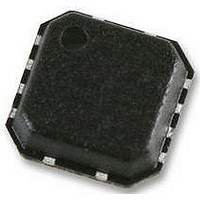AD8337BCPZ Analog Devices Inc, AD8337BCPZ Datasheet - Page 22

AD8337BCPZ
Manufacturer Part Number
AD8337BCPZ
Description
VGA, DC COUPLED, SMD, LFCSP-8, 8337
Manufacturer
Analog Devices Inc
Datasheet
1.AD8337BCPZ.pdf
(24 pages)
Specifications of AD8337BCPZ
No. Of Amplifiers
1
Bandwidth
280MHz
Gain Accuracy
3.5dB
No. Of Channels
1
Supply Voltage Range
4.5V To 10V
Amplifier Case Style
LFCSP
No. Of Pins
8
Operating Temperature Range
-40°C To
Lead Free Status / RoHS Status
Lead free / RoHS Compliant
Available stocks
Company
Part Number
Manufacturer
Quantity
Price
Company:
Part Number:
AD8337BCPZ
Manufacturer:
ADI
Quantity:
104
Company:
Part Number:
AD8337BCPZ-WP
Manufacturer:
STM
Quantity:
2 483
AD8337
The offset voltage effect of the AD8337, as with all VGAs, can
appear as a complex waveform when observed across the range
of V
a unique V
voltage range. The offset voltage profile seen in Figure 15 is a
typical example. If the V
output is the product of the V
voltage, and it can be observed on a scope as a small ac signal
as shown in Figure 74. In Figure 74, the signal applied to the
V
slightly less than 4 mV p-p.
The profile of the waveform shown in Figure 74 is consistent
over a wide range of signals from dc to about 20 kHz. Above
20 kHz, secondary artifacts can be generated due to the effects
of minor internal circuit tolerances, as seen in Figure 75. These
artifacts are caused by settling and time constants of the inter-
polator circuit and appear at the output as the voltage spikes
seen in Figure 75.
GAIN
GAIN
input is a 1 kHz ramp, and the output voltage signal is
–10
–10
10
–2
–4
–6
–8
10
–2
–4
–6
–8
–800
–800
8
6
4
2
0
8
6
4
2
0
voltage. Generated by multiple sources, each device has
V
V
OS
Figure 74. Offset Voltage vs. V
S
S
V
V
= ±2.5V
INPUT
OUTPUT
= ±2.5V
S
profile while the GAIN input is swept through its
S
INPUT
OUTPUT
–600
–600
= 2.5
= 2.5
Figure 75. V
–400
–400
GAIN
OS
–200
–200
Profile for a 50 kHz Ramp
input voltage is modulated, the
GAIN
V
V
GAIN
GAIN
SPIKE
and the dc profile of the offset
0
0
(mV)
(mV)
GAIN
200
200
for a 1 kHz Ramp
400
400
SPIKE
600
600
800
800
Rev. B | Page 22 of 24
Under certain circumstances, the product of V
offset profile plus spikes is a coherent spurious signal within
the signal band of interest and indistinguishable from desired
signals. In general, the slower the ramp applied to the GAIN
pin, the smaller the spikes are. In most applications, these
effects are benign and not an issue.
THERMAL CONSIDERATIONS
The thermal performance of LFCSPs, such as the AD8337,
departs significantly from that of leaded devices such as the
larger TSSOP or QFSP. In larger packages, heat is conducted
away from the die by the path provided by the bond wires and
the device leads. In LFCSPs, the heat transfer mechanisms are
surface-to-air radiation from the top and side surfaces of the
package and conduction through the metal solder pad on the
mounting surface of the device.
θ
of integrated circuits. Heat transfer away from the die is a 3-
dimensional dynamic, and the path is through the bond wires,
leads, and the six surfaces of the package. Because of the small
size of LFCSPs, the θ
is calculated using thermodynamic rules.
The θ
tab is soldered to the board and that there are three additional
ground layers beneath the device connected by at least four vias.
For a device with an unsoldered pad, the θ
becoming 138°C/W.
PSI (Ψ)
Table 2 lists a subset of the classic theta specification, Ψ
(Psi junction to top). θ
the die to the case, involving the six outside surfaces of the
package. Ψ
gradient from the junction (die) to each of the six surfaces.
Ψ can be different for each of the surfaces, but since the top of
the package is actually a fraction of a millimeter from the die,
the surface temperature of the package is very close to the die
temperature. The die temperature is calculated as the product
of the power dissipation and Ψ
ture and power dissipation are easily measured, it follows that the
die temperature is easily calculated. For example, for a dissipation
of 180 mW and a Ψ
less than 1°C higher than the surface temperature.
BOARD LAYOUT
Because the AD8337 is a high frequency device, board layout
is critical. It is very important to have a good ground plane
connection to the VCOM pin. Coupling through the ground
plane, from the output to the input, can cause peaking at higher
frequencies.
JC
is the traditional thermal metric found in the data sheets
JC
value of the AD8837 listed in Table 2 assumes that the
(XY)
is a subset of the theta value and the thermal
JT
JC
of 5.3°C/W, the die temperature is slightly
is not measured conventionally; instead, it
JC
is the metric of heat transfer from
JT
. Since the top surface tempera-
JC
nearly doubles,
GAIN
and the
JT








